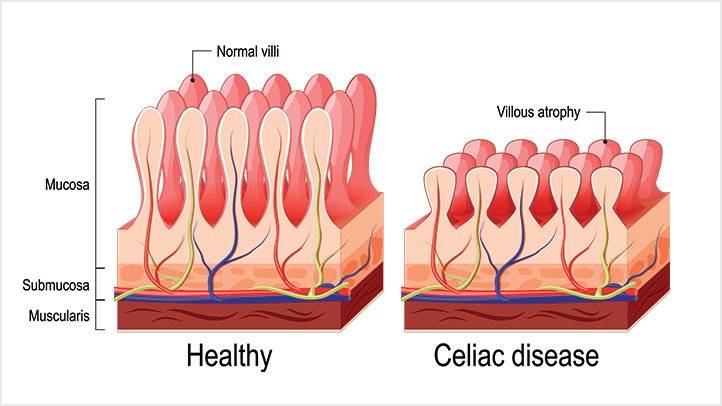Celiac disease is a long-term autoimmune disorder that mainly affects the cells of small intestine. Its association with other autoimmune diseases and in diabetes mellitus type 2 is also observed. The symptoms are those related to gastrointestinal problems.
This disease occurs as permanent intestinal problem in response to reaction of dietary gluten. Human small intestine consists of fingerlike projections-villi. Their purpose is absorption of food particle from intestine to body. In celiac disease, the villi get flattened and inflammation occurs. Flattening of villi leads to reduction in surface area as well as in absorption of nutrients. Consequently, deficiency of vitamins K and B6 and also for mineral such as iron and calcium, occurs in body.
Gluten is protein found in certain natural crops and their products. One the body is exposed to this protein, the immune response is production of autoantibody molecules that react with body’s own cells. Inflammation in small intestine lead to shortening and destruction of villi lining that reduced nutrient absorption.
Types of celiac disease
1. Nonresponsive celiac disease
About 30% patients of celiac disease do not tolerate the diet with gluten portion in it. This is termed as nonresponsive celiac disease. This occurs due to some inflammatory reaction to some pathogenic bacteria in gut wall. Therefore, it is necessary to see a dietitian for guidelines about what to eat and what to avoid.
2. Refractory celiac disease
This happens rarely but sometimes, the intestinal inflammation persists in patient after treatment and avoiding gluten-containing diet. This persistent inflammation results in mal-absoprtion of nutrients and the condition is known as refractory celiac disease.
Pathological mechanism of disease
The inflammatory reaction in cells of small intestine is mediated by cytokines secretion of T cells that lead to disruption of mucosal lining and villi cells. Nutrient absorption is reduced due to villi disruption.

Activation of innate immune system occurs by gluten protein that later activates the acquired immune system. Release of interleukin 15 by T cells induce enterocytes (cells of small intestine) killing by epithelial lymphocytes.
IgA is the secretary antibody in small intestine. Deficiency of IgA has been observed in celiac disorder as the cells secreting normal IgA are destroyed due to autoimmune response.
Symptoms of celiac disease
The symptoms may vary from person to person. Some commonly observed symptoms are:
- Diarrhea
- Fatigue
- Weakness
- Anemia
- Weight loss
- Dehydration
Sometimes constipation
- Abdominal cramps and distention
- Nausea and vomiting
- Osteoporosis
- Deficiency of vitamins lead to skin and dental issues such as dermatitis
- Miscarriages and infertility
- Muscular spam and cramps
What are the possible causes?
This disease may occur due to genetic and environmental factors and sometimes due to combination of both. Some conditions may result in this disease such as eating gluten food, infant feeding practice, gut infections and weak immune system lead to disease. Sometimes, certain conditions ‘trigger’ this disease such as pregnancy, miscarriage, undergoing some surgery or chemotherapy etc.
The encounter of body’s immune system with gluten food results in damaging villi and microvilli. These damaged villi cannot absorb essential vitamins and mineral from digested food and the body excrete them in feces.
Sometimes, genetic susceptibility plays its role to trigger the celiac disease. This increases the chances and risk factors. However, in some cases, the disease does not occur despite a person’s genetic susceptibility.
Risk factors
These conditions increase the risk factors of onset of disease in a person:
- Family history that already another member of family has this disease
- Diabetes militias type 1
- Genetic disorders such as Down syndrome and turner syndrome
- Autoimmune disorder
- Arthritis
- Addison’s disease
Complications
If not maintained and treated in time, the symptoms of celiac disease get complicated and may cause:
1. Malnutrition
Lesser absorption of essential nutrients from food, due to damaged villi, leads to malnutrition. Consequently, sudden weight loss and weakness occurs. In case of diarrhea, the situation gets worse due to dehydration and lack of mineral salts in body. Children suffer more as this hinders their growth and development and they become weak and immune compromised.
2. Bones and joint pain
When villi cannot absorb calcium from food, the body’s low calcium level directly affects bones and joints. This may lead to rickets or osteomalacia as well as osteoporosis and joint pain in adults.
3. Reproductive issues
The malnutrition in female body leads to reproductive issues such as infertility and miscarriages.
4. Lactose intolerance
Inflammation of gastrointestinal track results in lactose intolerance for almost all the diary products. This happens because the inflammation in gut and villi makes them less tolerant to various dairy products and their absorption and digestion. The persons experiences abdominal cramps and pains when consume some dairy product even if it does not contain gluten in it.
5. Neurological issues
In some patients of celiac disease, the person may experience peripheral neuropathy. This causes numbness in hand and feet and other related issues.
6. Cancer
Patients of celiac disease have greater risks of developing colon cancer, intestinal lymphoma and related form of cancer. The small inflammation may get too severe that it leads to cancer.
7. Poor growth and development
Children suffering from celiac disease are physically weak and it may hinder their normal growth and height compared to other normal children of same age. They may have delayed puberty and some congenital disorders.
8. Dermatitis herpetiformis
This refers to itchy and blistering skin condition which results from gluten intolerance in celiac disease. The doctor treats this condition with gluten free diet.
Diagnostic tests
Doctors may perform these two tests for diagnostic purpose:
- Serology tests: This test is basically to check the antibodies levels in your blood. Immune system develops certain antibodies against certain antigenic bacteria.
- Genetic tests: This test identifies leukocyte antigens in person. These are HLA-DQ2 and DQ8 for celiac disease.
- Endoscopy: If the genetic and serological test, doctors may perform endoscopy that is looking inside of intestine by inserting a camera.
- Biopsy: This involves detailed examination of small tissue section from small intestine.
Diets with gluten content
Prevention is always better than cure. This is better to avoid diet and foods that contain gluten in them. These are:
- Barley
- Farina
- Bulgur
- Malt
- Rey
- Graham floor
Similarly, some other product may have small contents of gluten in it:
- Preservatives and food stabilizers in canned food
- Vitamin and mineral supplements
- Some medicines
- Tooth paste and mouth wash
Treatment options
To reduce the small intestine’s inflammation, doctors prescribe some medicines. For instance, dapsone is recommended for treatment of dermatitis herpetiformis or skin rashes. In some cases, doctors recommend steroid therapy which includes prednisone. On the whole, avoiding the gluten free diet is best possible solution till now as there are no exact medicines for complete recovery of celiac disease.
Research for better therapeutics of celiac disease
Researchers focus on finding a better solution for complete recovery of the celiac disease. These researches are based on finding medicines that either bind or block the intestinal villi that overreact to gluten food. In this way, inflammatory reaction can be prevented. On the other hand, genetically modified crops GMO’s also focus on creating gluten free crops such as wheat. However, they have not yet been successful. Let’s hope that in near future, researchers will be able to develop a more reliable treatment method for celiac disease.

